As regular readers will know, I often refer to my sad top lists for everything – obviously, the big list of about 200 favourite video games, all in order, often comes up because it usually dictates what we’re looking at here, but we’ve also covered the top 25 albums, top 20 books, top 15 movies, top 10 singles… Then there’s specific lists like top ten horizontal schmups, Atari 2600 games, gaming soundtracks, gaming sights, gaming sunsets and so on. As I said, it’s sad but it makes me happy! Anyway, you join me today mid-new top list! Quite exciting too because we’re covering favourite toys as a kid, in no small part as a celebration of finally being reunited with my beloved Lego Space Transport, first released in 1979 but I think I got it for my 10th birthday in 1982, or possibly the one after, and it’s what I’ve always referred to as my favourite toy ever!
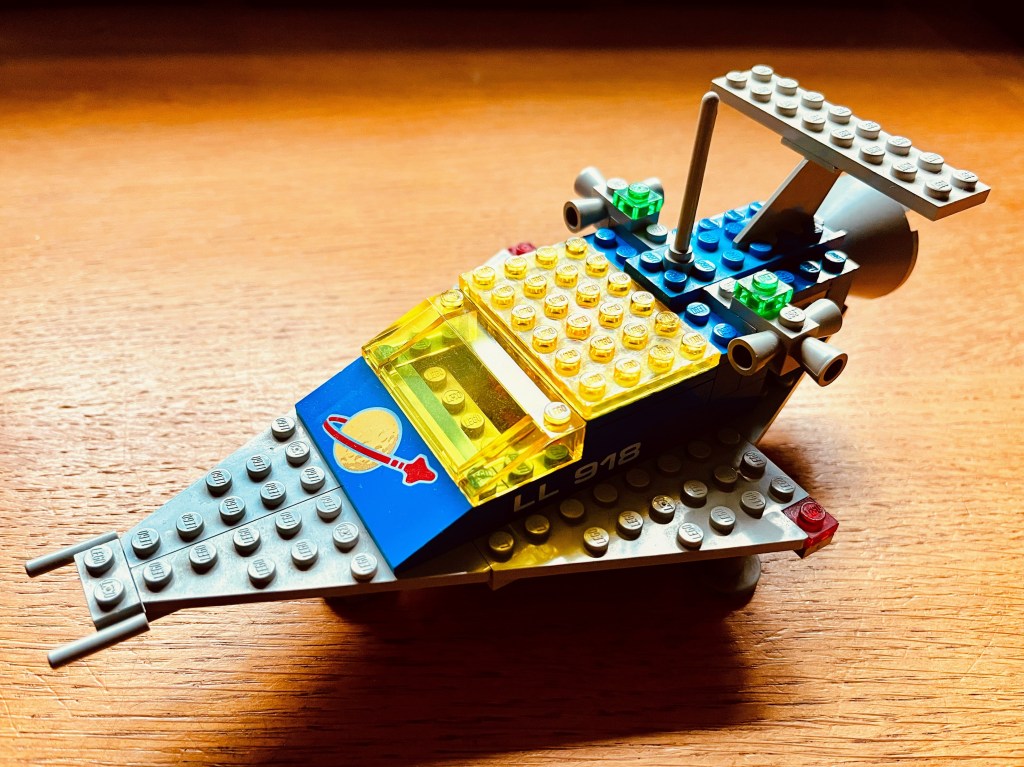
When I say “reunited” what I actually mean was patiently trawling eBay over a period of years for something near-complete and affordable (because the price of these complete is outrageous!) then finishing it off with any missing bits. Mine had long-since been consigned to a box of stuff for charity, unbeknown to me at the time I should add! I struck pretty lucky in the end though, with what was being sold as a complete set at a not quite outrageous price but had some wrong coloured bits – a tail attachment in particular, which I then spent months trying to get hold of in its original grey! Eight quid for a single Lego brick… unbelievable! Worth every penny in the end though – that glorious transparent yellow windscreen has still never been surpassed and the rest of the set is just so perfectly proportioned and full of detail! I should mention the other stuff I’ve come up with so far in the rest of this developing list but it’s not in any special order yet, so I’ll just throw a few things out there and we can come back to the rest another time! Actually, we did cover Snoopy Tennis here a long time ago, which I guess might even be in the number two spot, but then there’s a CHiPs accessory set, an Action Man training tower, a Star Wars Land of the Jawas playset, a Merit chemistry set, a Lego police van, an Action Man helicopter, a Space 1999 Eagle 1 Dinky toy spaceship, a Star Wars Imperial Troop Transport and last but certainly not least, an Evel Knievel Scramble Van. Which, in a roundabout way, is how we’ll eventually get to Eddie Kidd’s Jump Challenge!

Unless you were there it’s hard to appreciate quite how big a deal Evel Knievel was to a kid in the seventies and early eighties – maybe second only to Bruce Lee! He was part motorcycle daredevil and part entertainer, starting out as a kind of self-promoted carnival act, doing stunts and jumping over mountain lions and boxes of rattlesnakes and the like in the mid-sixties. This developed into a travelling show, focussing on increasingly flamboyant jumps that involved increasing numbers of cars and then larger vehicles, as well as an increasing number of broken bones that would become almost as much of a trademark as his later crazy stunts! One of his most famous came as early as 1967 when he decided to jump the fountains at Caesars Palace in Las Vegas, which he also paid to be professionally captured on film with what was the very last of his own money. Turned out to be a more worthwhile gamble than some in Las Vegas though, because the legendary footage of the resulting crash after his bike had lost power on the ramp up made him immortal and set his path to global fame… Once he’d recovered from the crushed pelvis and femur, fractured hip, wrist, both ankles and a concussion! Five months later he’d break his leg and foot trying to jump fifteen Ford Mustangs, but it didn’t put him off, although the $25,000 he was earning for every jump by now would have certainly sweetened the deal! The seventies then brought the spectacular, and while his dream Grand Canyon jump would never happen, the insane rocket Skycycle jump over the Snake River Canyon in Idaho came a close second, then there was the Wembley Stadium jump over thirteen buses in front of a crowd of 90,000, world-record setting car jumps (nineteen at the time) and even jumps over live shark tanks after Jaws captured the world’s imagination. Most of these involved crashes, which is probably why they’re so well remembered above the hundreds of others during that period, and I believe he still holds the record for surviving the most broken bones in a lifetime, numbering at least 433!
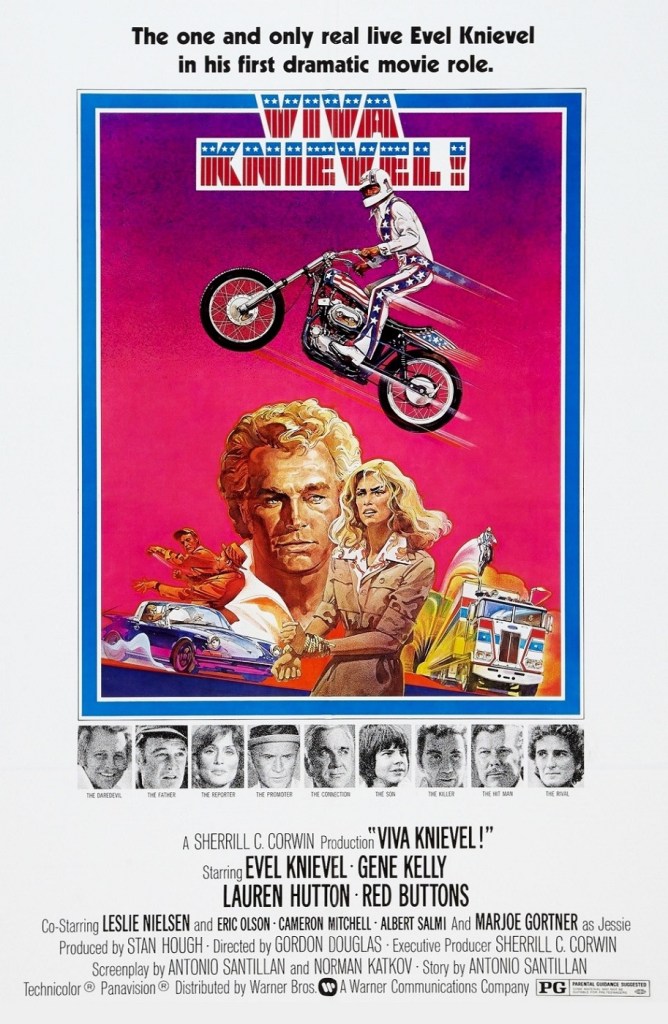
There was a 1971 biopic too, with George Hamilton as Evel Knievel, but coming back to my own recollections, as well as seeing his iconic madness on TV from time to time, I remember seeing Viva Knievel at the cinema on a rainy day on holiday in Great Yarmouth in 1977, which was a fictional story with him playing himself, and involved him creeping about in a orphanage at night delivering Evel Knievel action figures (although not exclusively)! What action figures they were though! Bendy, fully poseable Evel in his stars and stripes white jumpsuit and removable helmet (with a surprisingly realistic head underneath) that you could contort into various positions for the most spectacular jumps over planks of wood on bricks! There was a regular bike to do that on, and I had a big stunt bike too, and they came with a weird red stand that you frantically wound up to rev them up and shoot off! There were proper stunt sets too that were never quite as much fun as building your own monstrosities, and a load of other vehicles like a dragster, a jet bike, a chopper bike, the Canyon Sky Cycle rocket thing, the Funny Car, the CB Van and, of course, where we began, the Scramble Van! This was part of the original line-up of toys based on his travelling stunt show, originally released in 1973, and was a kind of converted truck with a living area and slide-out workshop, as well as a three-part ramp that allowed you to jump the van itself with one of your bikes, and a ton of accessories, right down to coffee cups and a chair to drink it in, or individual tools to use at the workbench. There was loads to lose down the back of settees here, and everything opened up to reveal detailed printed panels on the other side of the star-spangled exterior. Most of all I can remember the smell of this thing though – a lovely rubbery plastic smell, like you’d get in one of those wendy houses for the garden (with the poles that always ended up snapping at the connectors) when they were new!

All a bit too early for video games though, and I was racking my brain trying to remember if there’d ever been any Evel Knievel games since, before I turned to Google to save me the bother, and had totally forgotten I’d actually bought one on iOS before everything (including that!) went free-to-play. Evel Knievel, as it’s still called, first came out in 2016, and is possibly the last game I actually paid money for on there, although I did since pay for that Super Mario Run in-game unlock. Worth every penny that was too! Anyway, this one is an average Trials-like – think Diet Trials, with all the frustration but without any of the finesse that means it gets a pass.

All the way back in 1999 there was a Game Boy Color Evel Knievel too, by Rockstar Games of Grand Theft Auto fame, no less! I’d never even even heard of this one before but it’s not too big a stretch to get there from the iOS game just now! Pre-Trials by a year though, so we’ll call it Kikstart-like instead! Whatever, it’s cruel physics-based 2D motorbiking across some suitably glamorous settings with some very slick and impressively smooth presentation. Surprising depth too, with fuel as well as power to worry about, and it feels good when you get the hang of it. Almost Trials-like! But was it really Evel Knievel-like?
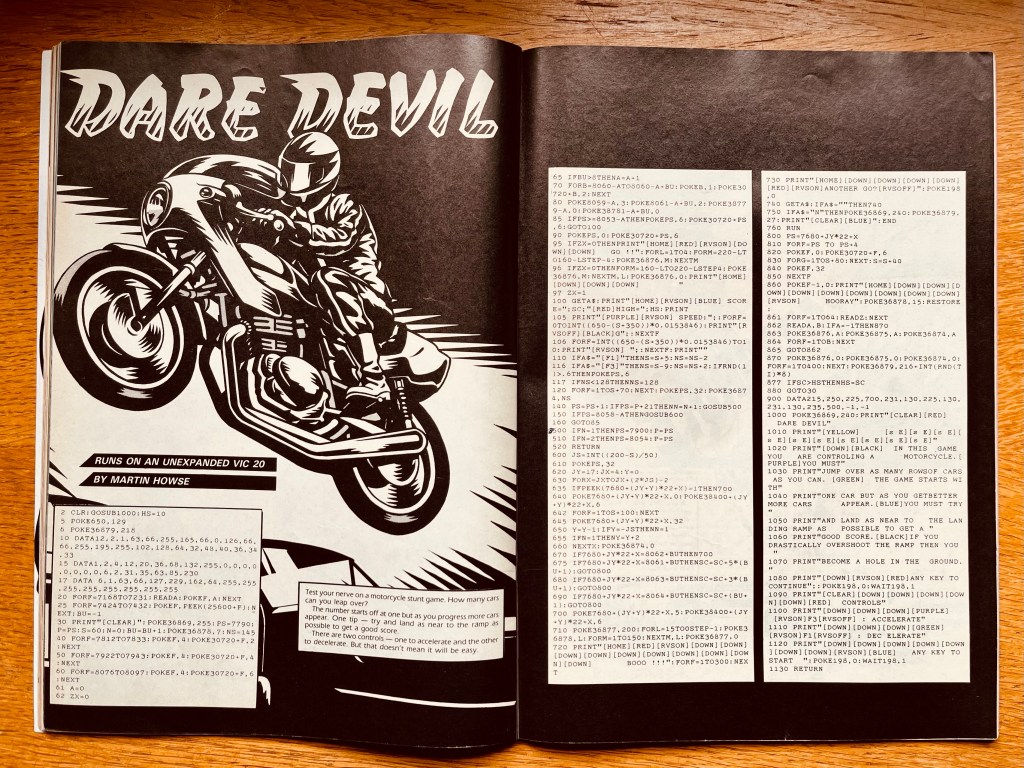
Well, he did start out doing motocross, but what we really needed was Evel Knievel for the Atari 2600 – no frills, no messing around, just jumping over stuff. Would have been great! But in the absence of that, the closest I came for a while was Dare Devil, a type-in by Martin Howse for the unexpanded Commodore VIC-20 in the August 1985 issue of Computer & Video Games magazine! These were the glory days of the do-it-yourself listing, when a good quarter of a magazine might be type-ins for all the popular systems of the day, as well as those possibly on the decline, just to keep you buying once the proper game reviews had all but dried up! Other type-in highlights this month were Labyrinth on the BBC, a Minotaur-based maze-game bizarrely also involving balls of thread; on the Spectrum there was Apple Crazy, where you were a farmer catching apples in your basket; and over on the C64 there was Parachute, with you travelling down the abandoned mines of Planet X by parachute. Only in the eighties!

I always loved a good type-in! I had a bunch of books full of them for the VIC-20, and could never resist one in a magazine. Okay, the games were rarely classics but you occasionally got a gem, and at the very least, it was good to see the workings of a game emerging and was always a bonus when they worked at all after all that typing, however it played! Dare Devil wasn’t an easy one to follow, with lots of mysterious POKEs and DATA commands, but the game itself did indeed work and it wasn’t bad! There’s two screens of instructions (which you already know because you typed them in), one telling you how to play and one for controls, although I’m not sure F3 to accelerate and F1 to decelerate needed a screen of its own, then you’re ready to jump! At the bottom of the screen there’s a single car between two ramps, and your bike’s at the top, ready for its run-up across several rows of road. On the way, you need to adjust your speed to make the jump, ideally landing somewhere near the second ramp! Make the jump and you get another car added for the next jump, and so on. Fail and you’re a hole in the ground, to quote the how to play page! It’s incredibly simple but there’s something very addictive about having one more go with the slight speed adjustment you needed the last time. As we’re about to find out with our feature game. At last!
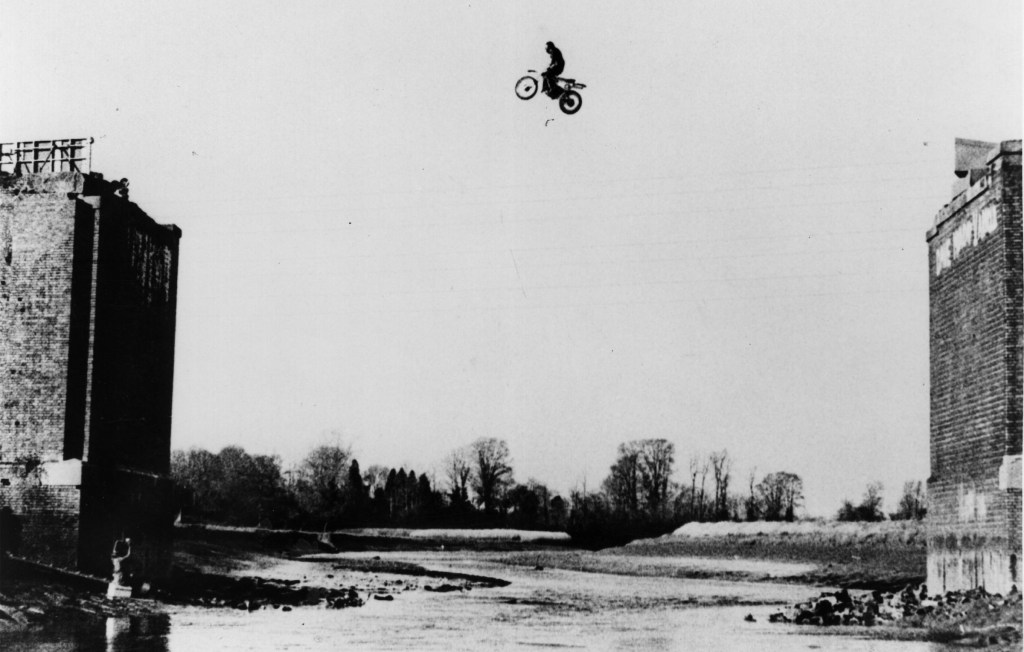
We might only have had Evel Knievel very fleetingly in the UK, but for the times when he wasn’t over here breaking his pelvis at Wembley Stadium, we had our own alternative, and his name was Eddie Kidd! As well as being a stunt double for James Bond, Michael Caine, Harrison Ford and Val Kilmer, he held a few world records for jumping over cars and buses of his own, and became almost as well-known as Evel Knievel in the early eighties. I actually saw his touring show in Bedford around then where apparently he jumped some buses but I really don’t remember much about it! What he is sadly remembered for now is the massive accident he had in 1996 that left him with brain damage and paralysed. Wasn’t a particularly big jump either, but when he landed his chin bounced off the bike’s petrol tank, knocked him unconscious, and while unconscious the bike went over an embankment and that was that. But that wasn’t the end of Eddie Kidd though, and while we could cover all sorts he’s been up to since, I’ll leave you with what he called his greatest stunt, when he started the 2011 London Marathon in a wheelchair, got out of it and started walking, and completed the race around two months later! Credit to Getty Images for the pic of him here. Speaking of pics…

As well as all that stunt-doubling and over 12,000 career jumps – most of which happened years before he got a motorcycle licence in 1995 – he had a singing career that spanned two albums and the unforgettable single, Leave it to the Kidd, as well as a modelling career for various shampoos and Levi’s in the mid-eighties. And that’s where we’re heading now, and 1984 to be precise, for Eddie Kidd’s Jump Challenge… And maybe even the Evel Knievel game we always wanted! The game was by Martech, who came up with a few of the earlier licensed games before Ocean turned it into an art form, of which this was one of the first, but you might also know them for the likes of Geoff Capes Strong Man, Brian Jacks Superstar Challenge or the highly erotic Samantha Fox Strip Poker! They did Nemesis the Warlock too, a not terrible 2000A.D. license with an incredible Rob Hubbard soundtrack on the Commodore 64 version! Anyway, Eddie Kidd also came out on there, the Spectrum, MSX, BBC B and Acorn Electron, a variety of which seem to be represented on the back on the box, which in my case was from the 1985 budget rerelease on Mastertronic’s Ricochet label.

“If you’ve ever wondered how it feels to be Eddie Kidd… defying danger and gravity, soaring on a motor-bike over a long line of cars… here’s your chance to find out! This fabulous new game – Jump Challenge – has been produced for you with a lot of help from Eddie himself.” Hmmm, new game is a stretch and the unnecessary use of hyphens is almost as strange as Martech’s fear of apostrophes, but it was £1.99 so what do you expect? Actually, what you can expect is a ridiculous amount of the world’s smallest text across the whole triple-aspect cassette inlay, accompanied by the kind of picture of Eddie that’s going to get you one of those shampoo gigs! What’s more important, though, is that the tiny text tells us that we’re now an “Official Jump Challenge Contender” and apparently we’ll find a card in the package that we need to put in a safe place in case we win a prize in the “Official Jump Challenge Competition” and need to produce it! The quotation marks here aren’t for my effect, by the way; it’s how these things are officially written, but if I then use quotation marks to show that it’s going to look weird! Anyway, as well as that, we’ll also need it to redeem any further offers still to be announced, but in the meantime, there’s also a sticker in the box, and this bit needs to be quoted properly! “You will also find an “Official Jump Challenge Contender” sticker. When the back of this has been peeled off, it may be stuck onto a bike, bag, book or a bar, for example.” Well, as much as I appreciate the explanation of how a sticker works, I’d have appreciated either the card or the sticker actually being in the box even more now you’ve told me about them. They weren’t, and I never heard anything about competitions or further offers, but again, £1.99 and all that.
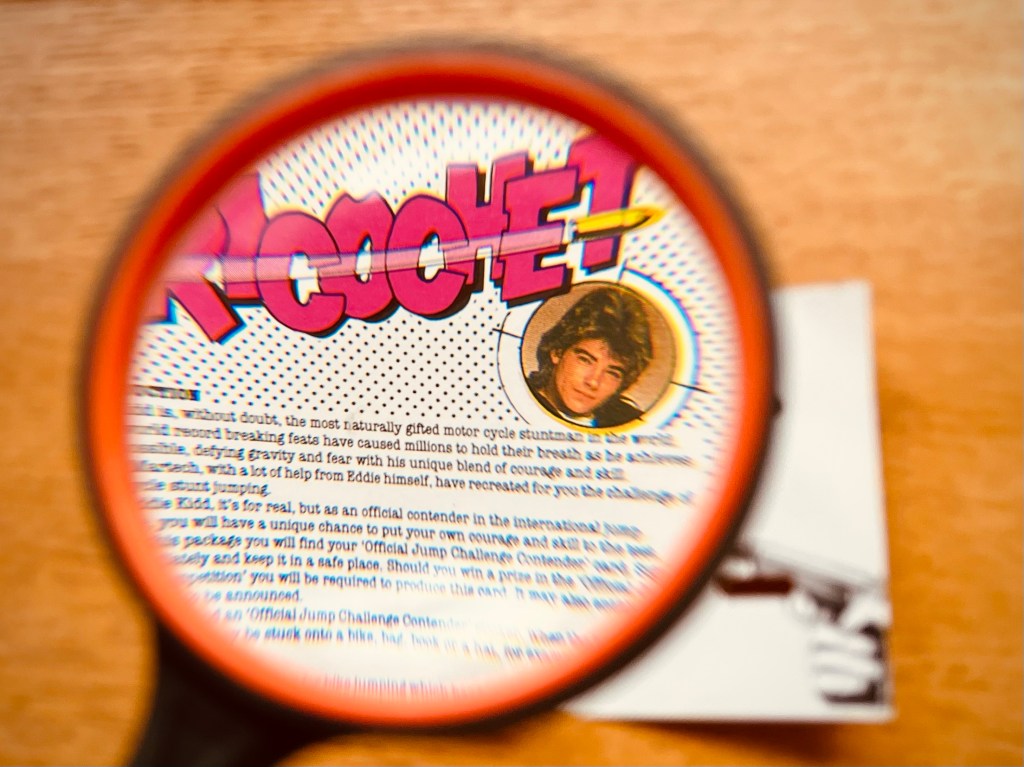
Expectations duly squashed, let’s check out the instructions. We’re told that it’s Eddie Kidd’s “instinctive “feel”” (see!) for the bike that has brought him to the very top of his profession, and that his 190-feet jumping world record all happened without accurately measured run-ups or the aid of rev counters or speedometers! And that’s what you’re now also expected to do it the game – all about the feel, so you need to develop the necessary control and timing to be able to successfully progress to more difficult jumps, and only by having the courage to push yourself to your very limits will you truly become Eddie! But first you need to jump over some barrels on a BMX! And with that, up and down is throttle, fire is brake, left and right are lean back and forth. You can also turn the bike, Defender-style, with a press of Enter to set your run up distance or even abort if you’re not feeling the Force. And if you’re playing on C64 or that weird Amstrad thing it’s also function or number keys for the five gears when you progress to a motorbike but no mention in the Spectrum controls section so we’ll see how that goes…
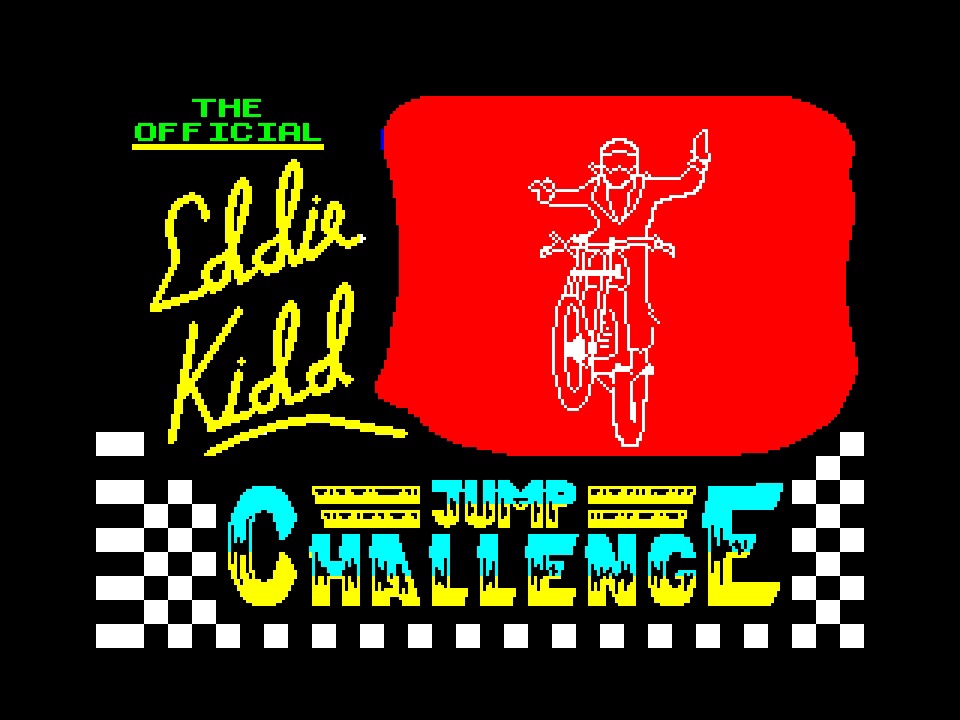
If only I’d thought of this delightful example when I was doing my top ten Spectrum loading screens countdown! Once you’re past that, there’s just a selection of keyboard or Interface 2 joystick between you and your BMX. No gears to worry so we’ll just turn straight around, hit top speed and hope for the best! And that works fine as you go up the ramp, enjoy the massive colour clash as your tiny bike transitions from road to sky with a fence in-between, and soar over an impressive amount of barrels – eighteen of them, it says! No down ramp to worry about yet either, or even leaning – just hit top speed and watch it land. Any less than that and you’ll crash but ignore the suspect collision detection here because this is just setting things up and not relevant to scoring. The presentation in-game is almost as barebones as getting into one but what you do get in this bit exclusively is some frantic pedalling animation on what’s admittedly just a stick man, although it’s not just his legs on the move because, very strangely, there’s at least one arm on the go too! Apart from that, any sense of movement is pretty much restricted to some very jerky scrolling fences, ramps and obstacles, but it’s all so small-scale that you barely notice it. What you should notice, though, is that road markings and backgrounds are scrolling in glorious parallax, and how often do you see that in a Spectrum game from 1984 that you’ve paid £1.99 for?
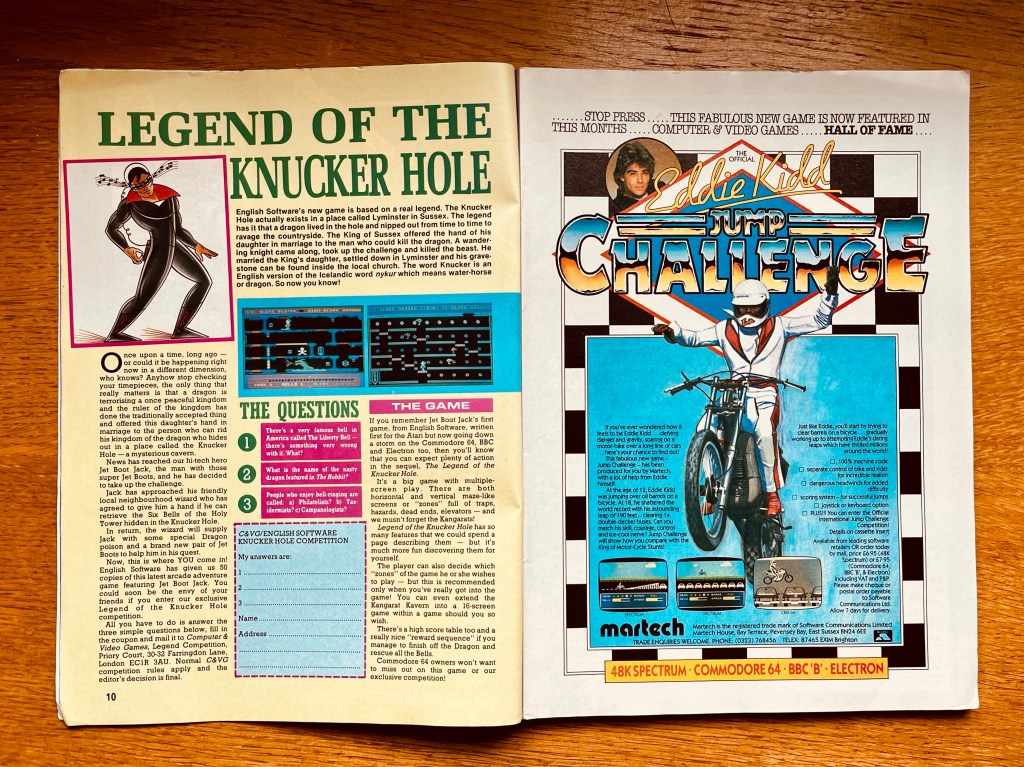
Right, time to stop admiring the scenery and get serious because we’re on a proper big-boy motorbike now, and we’ve got eight cars positioned between two surprisingly well-engineered ramps that need our attention! While the distance you need to hit the ramp might be all about “feeling” things, the bottom third of the screen is taken up by all the stuff you were told you didn’t need earlier on, with your current gear and brake status highlighted, your revs and speed below them, the current number of cars to jump and your score below them, and finally a wind sock at the bottom showing wind strength and direction, just to give you a bit more to think about as you progress. What you’ll quickly realise way before that, though, is for the run-up you can forget feeling things because it’s all about that speedo whatever the instructions tell you, although in reality I found myself watching the gear indicator and the rev counter below it more because you can then use the gear numbers above to properly gauge your revs, where using the visual-only speedo isn’t so easy! By the way, the gears on the Spectrum version change automatically, which I appreciate!
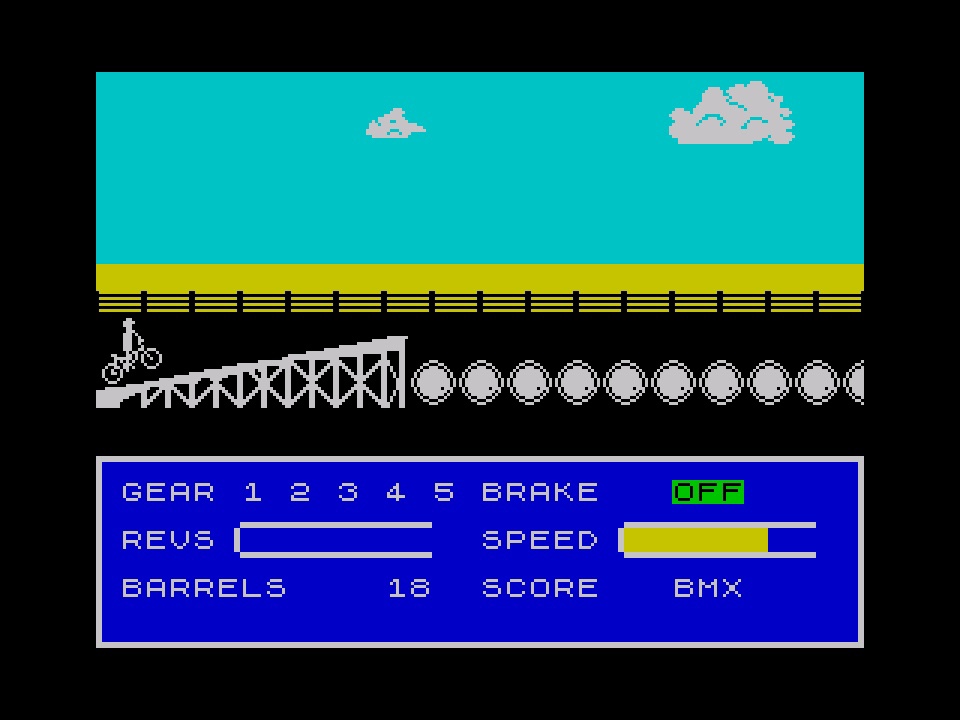
Once you’re airborne all that becomes irrelevant because all you’re worried about now is hitting the landing, assuming you got the speed spot on because otherwise everything is irrelevant too and it’s game over! Coming back to feeling again, this bit is pretty intuitive, albeit a bit twitchy, although in its defence I guess flying through the air at 100mph with a super-bike between your legs is also a bit twitchy! Anyway, you’re adjusting your body forward and back, which in turn is adjusting where the bike’s wheels are going to hit the ramp, so ideally you want a tiny bit of back wheel first before the front elegantly touches down fractionally after. And good luck with that, rather than a full-on back or front wheelie! The crash animation is really cool though – I joked about basic BMX-boy earlier, and it was crap, but there’s more heft to everything now and you get a nice ragdoll somersault down the ramp as you detach from the bike, followed by Eddie getting up and raising his fist once you’ve come to a sorry halt.
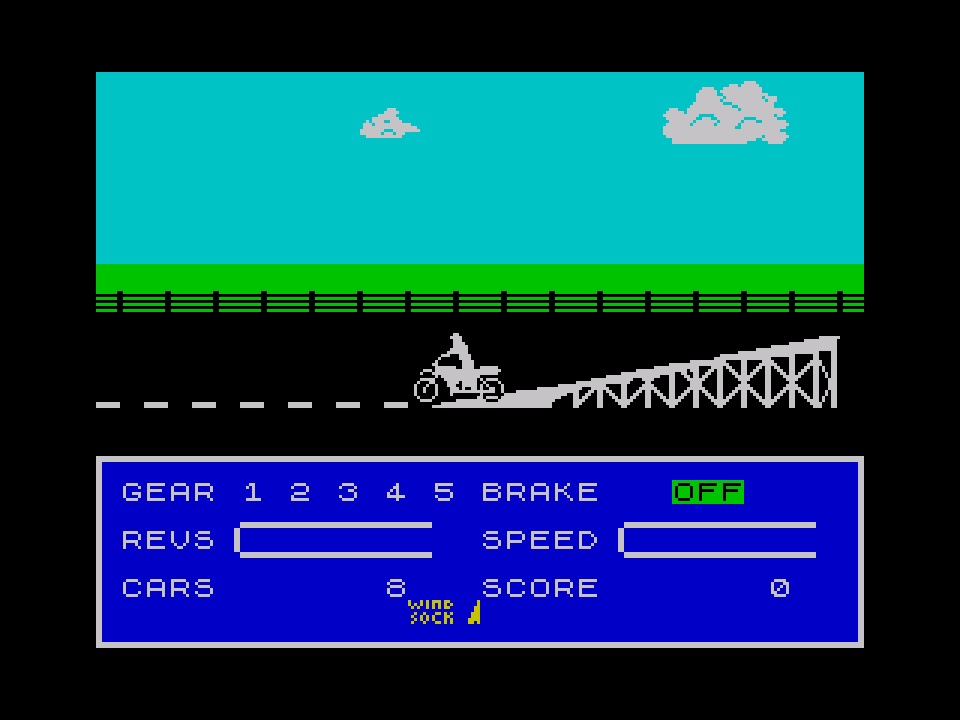
There’s no escaping this game isn’t about the graphics. Or the sound, which is restricted to a clicky, raspy little white-noise for the engine and is precisely as you’d expect here! The bike is recognisably a bike though, even if it is all white, just like the rider, so it becomes a blob of white (or black or just an unrecognisable mess, depending on your current altitude) with the only movement your forward and back motion, at least until you crash. No wheel animation or anything fancy. Apart from that, you’re on a black road with white markings, and there’s a black fence with a narrow, solid green rectangle of field behind it, with the sky and a couple of clouds behind that, which I’ve just realised offer another layer of parallax-effect scrolling, so we’re all good and duly impressed after all! As mentioned earlier, a bit of effort has been made with the criss-cross woodwork in the ramps, but they’re also totally white, as are some very basic (or even BASIC) cars to jump over.

We already know very well that this game’s about how it feels and not presentation though, and like that type-in on the VIC-20, there’s something very addictive about nailing the speed as you progress through the increasingly large (by one car at a time) jump, but then you’ve also the added depth of that front and back lean, which is a genuinely tense affair because you pretty much immediately know if you’ve nailed the speed once you take off, and in reality you just need to work out what that speed needs to be for each number of cars then rinse and repeat. But, together with the wind, what goes on with both bike and rider in the air will totally dictate whether all that effort is going to pay off with a bigger jump or relegate you back to a BMX again! Assuming you do survive, you’re also awarded a score for your jump, which I’ve never totally worked out but I think is affected by where on the ramp you land and how you land, and it is possible to successfully land but score zero, meaning you have to do the jump again. It is more about number of cars jumped than score though, but all the same, all that text in the instructions and they don’t even mention it!
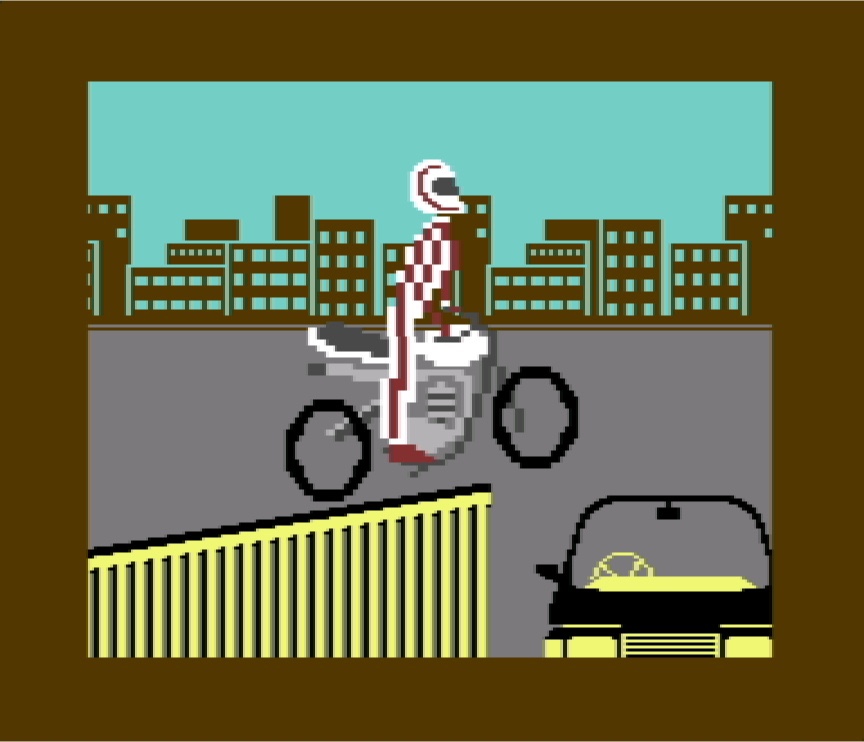
There’s something I need to mention though, and that’s the Commodore 64 version. It looks amazing! The objective is fundamentally the same but the graphics here are a whole other level! The entire screen is filled with your huge, distinct, fully-featured rider on his bike, still scrolling like crap, mind, against the most C64 (meaning brown!) cityscape you could wish for, and the animation is great! There’s a ton of detail in the ramp and line-up of cars too, and when you crash Eddie limps off to the sound of an ambulance siren in the background, followed by a big message about hoping you like hospital food. Coming back to the controls, this version really is about “feel” as well because there’s no rev counters and all that stuff, so it’s all about those manual gears and the sound of the engine. You can move up and down in the seat now too, but there’s no scores here either – it’s just about the number of cars you jumped, and as already stated, that’s good. Impressive as it is though, it’s a bit too in-your-face for my liking – the view is so close-up you can’t see the ramp coming before you hit it, so timing your landing (especially with all those directional rider controls) becomes a real challenge. And for a game so reliant on speed (not to mention feel), it’s really missing any feeling of speed. Could really do with something in the middle – now that would make a great Evel Knievel game too if anyone’s listening!
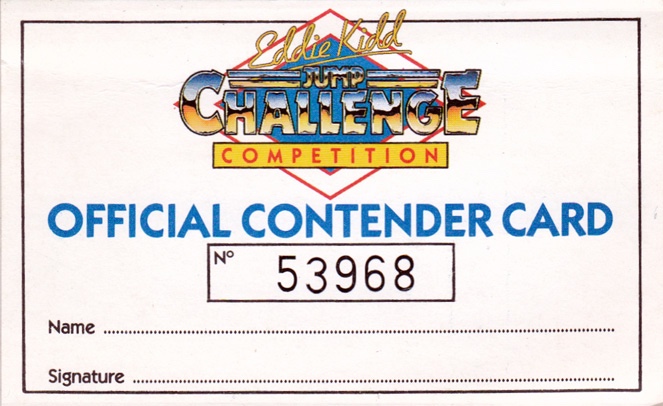
Eddie Kidd might not quite be Evel Knievel, and there might not be much to Eddie Kidd Jump Challenge – particularly on the Spectrum – but I’ve always had so much fun with this! I still had my VIC-20 when it first came out but I remember enviously seeing the adverts in Computer & Video Games magazine and knowing it was only a matter of time! Funnily enough though, with all those Evel Knievel toys – that sadly had been long-since ended up “somewhere else” by then – we’d already experienced the thrill of the motorbike jump, so playing this wasn’t like a flight sim or something else that far out of reach, but there was definitely still something here that captured the danger and the glamour we were all still entranced by at that point, and to this day there’s still something about getting the speed just right for one more car! Simple things… And good old Eddie Kidd. An inspiration then but an even bigger one since, and I reckon it’s a game he can be proud of!


This was the first thing I did after uni and learning z80. Nice to see someone remembers it. It got to #3 on BBC Swapshop chart. And I did meet Eddie briefly with his manager and can recall that he was quite quiet but had an impressive ankle length leather coat !
LikeLiked by 1 person
Wonderful! You finding this has made my day. And thank you for all the enjoyment!
LikeLike